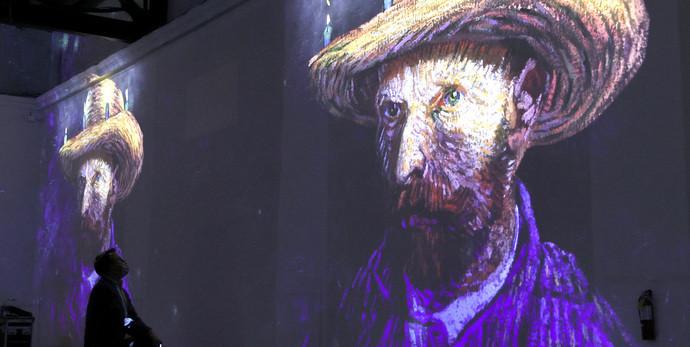
For Van Gogh, perhaps in addition to admiring his classic paintings, it is necessary to listen to his monologues that appeal to the pen to truly understand Van Gogh. The "Listen to Van Gogh" set includes the "Listen to Van Gogh" collection of letters (first and second volumes), the "Van Gogh Talk and Painting" album and the cultural and creative notebook.
The real artists are all strong, the individual supremacists who transcend the existing paradigm of art and go their own way, they are the backbone of history, and there are only a few people in a century.
Vincent van Gogh, a fanatical and rational genius painter. Say he's fanatical because of his intensely scalding works, his Arles, his starry sky, his sunflowers. Vincent was born for burning.
People visit van Gogh's immersive painting exhibition.
To say that he is rational is that every stroke of his painting is passionate sanity. His fluid and rational brushstrokes, many of his signatures are hidden in the picture, so perfect, even incredible. His judgment and cognition of the works of artists such as Delacroix and Miller reflect his sensitivity, sharpness, originality and rationality. The maturity of art in Vincent fully demonstrates his inner firmness, and he cultivates his canvas like a shoemaker. He was convinced that one day the world would learn to spell his hard-to-spell name: Vincent Willem van Gogh.
Years ago, when I read Van Gogh, I said that Vincent could not just watch, but also need to listen, that viewing was too superficial, that the trajectory of genius was mysterious and elusive, and that it was not enough to use only one pair of eyes. "Listening to Van Gogh" is Van Gogh's personal account, and his correspondence with his brother Theo details his thoughts, creations and life aspirations. The book is divided into two volumes, and the album volume allows you to see the complete face of Vincent's mentioned works.
Vincent turned the heat into rushing colors and unbridled brushstrokes. He uses "abundance" to express his colors. In the eyes of the secular people, he is the madman Van Gogh, his creation is crazy, and his color is pathological. Think about it, in the eyes of people at that time, in the face of such a Vincent van Gogh, how could they have other expressions? But I would say to Vincent: When you are resisted by secular theories and paintings, the great "Van Gogh" is born.
Starry Night on the Rhône
Van Gogh, the genius, was not accepted by the mainstream art scene in Paris at the time during his lifetime, and he was indeed very depressed. In the early spring of 1888 he went south to Arles, where, in about 15 months, he completed works such as Starry Sky, Starry Night on the Rhône, Pont Du Pont-d'Lonlou in Arles, and Open-air Café at Night.
Van Gogh said: "For me, the night looks more vibrant, richer, more colorful than the day, painting at night, there are twinkling stars in the sky, there are mysterious lights on the ground, the picture is beautiful, it is a peaceful work." Vincent's paintings are the scenes he knows best—the wilderness, the farmers, a bouquet of wildflowers, a sunflower, a basket of potatoes, a piece of the sky—all with great enthusiasm. He is pure and rich, and his art exudes the vitality of life and the aroma of earth. Vincent must have relied on the hand of God in such a depressed and bitter years, otherwise how could there be such a brilliant picture?
Visitors view a self-portrait by the Dutch painter Van Gogh.
In his letter to Theo, Vincent said: "Everyone has a fire in their heart, but those who pass by see only smoke." But there is always someone, there is always someone who can see this fire and come and walk with me. Vincent was sleepy, but how fortunate he was to have thousands of people with him after "leaving.". He is already the sun in the sky.
(The author is an artist, Doctor of Literature, researcher of the China Academy of Arts, professor of Complutense University in Spain)
Listening to Van Gogh
[Netherlands] by Vincent van Gogh translated by Zong Duanhua, China Publishing Group, China Translation Publishing House